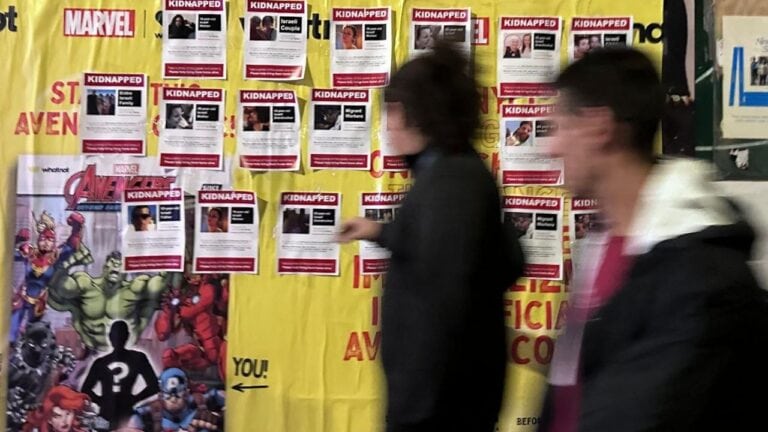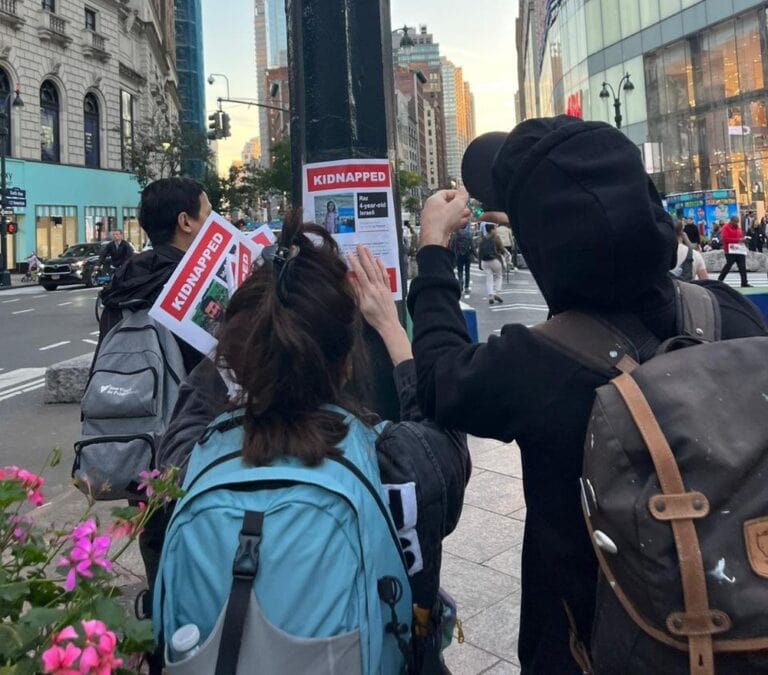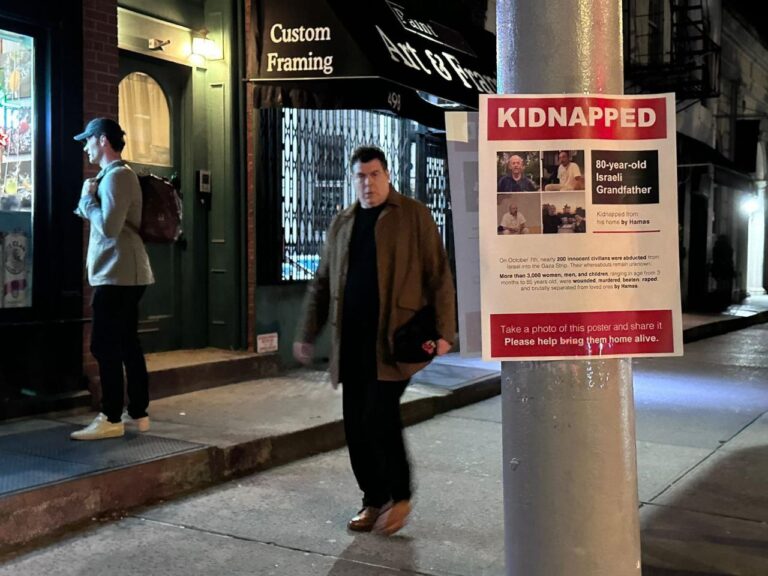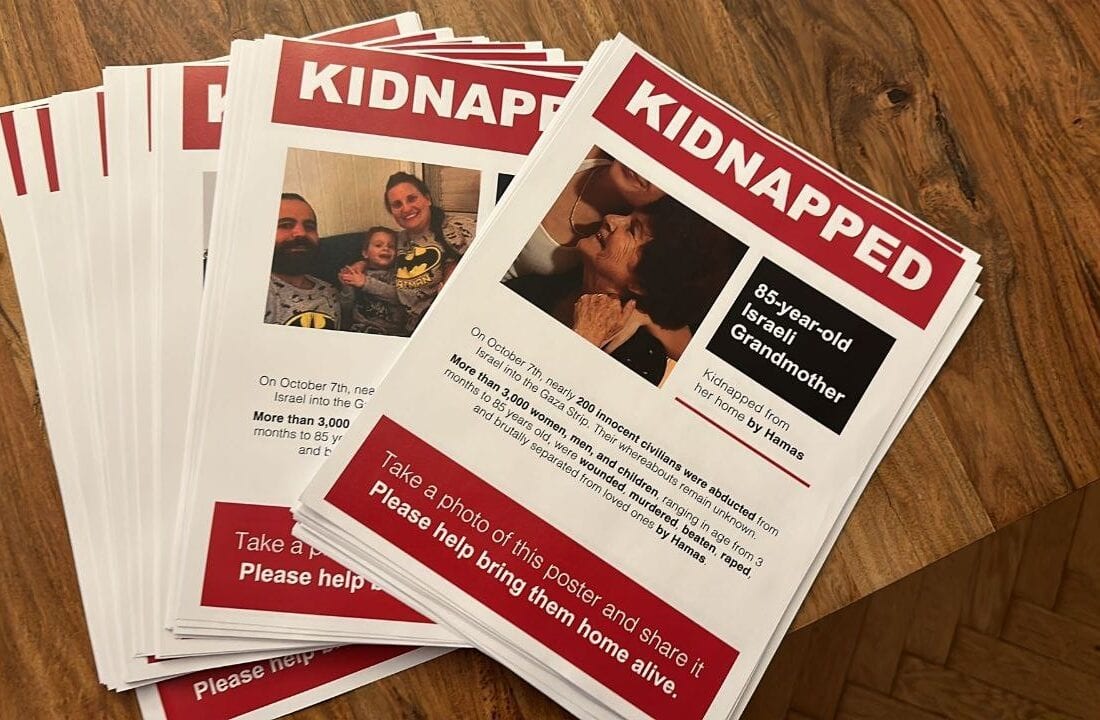Unless you have been living under a rock for the past few weeks, you have probably heard about the international information campaign to raise awareness of Israeli civilians who are being held captive by Hamas in the Gaza Strip.
On October 7, thousands of terrorists descended on southern Israel, unleashing a deadly and brutal attack. Over 1,400 people were killed in the onslaught and more than 230 were kidnapped and taken to Gaza as hostages.
Street artists and life partners Dede Bandaid , 36, and Nitzan Mintz, 32, were among many Israelis who felt paralyzing horror after hearing the news of the attack.
Far from home
“It was nighttime here in New York when we started getting text messages and calls from home,” Dede tells ISRAEL21c, adding the couple had recently moved to the United States to take part in an art program.
“Initially, we didn’t understand the scope of it all. So we just went to sleep.”
When the pair woke up the next morning, the scale of the tragedy was clear. “As the day went on, the numbers [of the dead and kidnapped] kept going up. We felt so helpless, we didn’t know what we could do, especially being so far away from home,” he recalls.
With both Dede and Nitzan being veteran street artists, the two began brainstorming an idea that would bring the plea to free the hostages to the public sphere overseas.
They eventually landed on the idea of taking advertisements of missing children on milk cartons, which were popular in the US in the 1980s, and replacing them with hostages, with the word “kidnapped” printed above each picture.

“We thought it would be fitting [for the US] and people would pay attention to it.”
Dede and Nitzan recruited Tal Huber, an Israel-based web designer, to help with the design of the flyers. Some 48 hours after the attack, the pair were already putting up some 2,000 small posters they had printed all across New York City.

The couple, however, quickly realized they were out of depth with the task at hand. “After a full day of putting up the flyers, we were physically shattered.”
They decided to issue a call for help on social media, enabling people to download the poster design via a Dropbox link, print it and put it up wherever they are in the world.
“In order to have an impact, it had to be out there en masse. Two people couldn’t do it, although we would not have stopped either way,” he admits.
Guerilla campaign
The next morning the two woke up to hundreds of messages from people all over the globe, who had downloaded the design, printed it and were out and about hanging up the flyers.
“It became viral overnight!” he exclaims.

Three weeks on, and the spontaneous guerrilla initiative has turned into one of the biggest information campaigns in the world. Thanks no least to the thousands of volunteers.
“The campaign is not sponsored by anyone,” adds Dede.
Dede and Nitzan later set up a website dedicated to the campaign — named Kidnapped from Israel — as more and more victims, who originally had been labeled as missing, are being reclassified as hostages.
The families of the hostages send over the images and information they wish to be added to the posters, with the poster designs being updated every two hours on the website. The designs have so far been translated into 30 languages.
“All the pictures and details [that appear on the posters] were approved by the families, we don’t allow anyone to make changes to the designs because it would be disrespectful to the families,” notes Dede.
They tear down, we build back up
When talking about this campaign, it’s hard not to mention the effort being made by anti-Israel activists to tear down the flyers wherever they come across them.
This led to the Kidnapped from Israel campaign members recording people who tear down the flyers, catching the perpetrators in the act. The videos are often shared on social media, where the anti-Israel activists are then identified and reported to their respective employers.
Among the most active organizations that has been tracking down those who are tearing down the flyers is Stop Antisemitism, a non-partisan US-based organization fighting antisemitism.
Miami – two men were spotted removing posters of Israelis kidnapped by Hamas in the Brickell area.
— StopAntisemitism (@StopAntisemites) October 18, 2023
The men appear to be dentist Ahmed ElKoussa (left) and Xave Ramoul (right). pic.twitter.com/cl2Sec8WlA
“The public space is open to everyone, including those who have opinions different from ours, those who’ve been influenced by the media, brainwashed or whatever else,” says Dede.
He adds that ultimately, the videos of the people ripping down the flyers only helped the campaign to stay in the headlines and trending on social media.
“It also unmasked those people. People who are ripping flyers of babies being held hostage are inhumane.”
Dede admits they also get negative feedback on their social media, which sometimes involves profanity and even threats.
“All we want is for the hostages to return home, and if we manage to make the slightest change to help make that happen, we will have done our part.”
For more information on the Kidnapped from Israel campaign, click here














